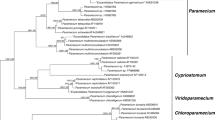Abstract
Neorickettsia are endosymbiotic bacteria that infect digeneans (Trematoda). These bacteria are of interest worldwide because of their ability to move from the parasite to its host, where they can cause serious diseases of humans and animals. While several disease-forming species of Neorickettsia have been well studied, and numerous Neorickettsia types have been identified in regions such as North America and parts of Asia, records from other locations are sparse. To date, there have been no reports of Neorickettsia from New Zealand. We screened ten species of digeneans infecting seven native gastropod species (both marine and freshwater) found near Dunedin, New Zealand, for the presence of neorickettsial infections. A >1300 bp long section of 16S rRNA belonging to a Neorickettsia bacterium was isolated from opecoelid digeneans of two individuals of the mudflat topshell snail Diloma subrostrata. These sequences represent the first evidence of neorickettsial infection in native New Zealand animals and are also the first Neorickettsia found in digeneans of the family Opecoelidae.

Similar content being viewed by others
References
Cordy DR, Gorham JR (1950) The pathology and etiology of salmon poisoning disease in the dog and fox. Am J Pathol 23:617–637
Dheilly NM, Poulin R, Thomas F (2015) Biological warfare: microorganisms as drivers of host-parasite interactions. Infec Genet Evol 34:251–259
Fukuda T, Kitao T, Keida Y (1954) Studies on the causative agent of “Hyuganetsu” disease. 11. Characteristics of the rickettsia-like organisms isolated from metacercaria of Stellantchasmus falcatus. J Japan Assoc Infect Dis 47:474–482
Greiman SE, Tkach VV, Pulis E, Fayton TJ, Curran SS (2014) Large scale screening of digeneans for Neorickettsia endosymbionts using real-time PCR reveals new Neorickettsia genotypes, host associations and geographic records. PLoS One 9, e98453
Guindon S, Gascuel O (2003) A simple, fast, and accurate algorithm to estimate large phylogenies by maximum likelihood. Syst Biol 52:696–704
Holland CJ, Ristic M, Huxsoll DL, Cole AI, Rapmund G (1985) Adaptation of Ehrlichia sennetsu to canine blood monocytes: preliminary structural and serological studies with cell culture-derived Ehrlichia sennetsu. Infect Immun 48:366–371
Leung TLF, Donald KM, Keeney DB, Koehler AV, Peoples RC, Poulin R (2009) Trematode parasites of Otago Harbour (New Zealand) soft-sediment intertidal ecosystems: life cycles, ecological roles and DNA barcodes. New Zealand J Mar Freshwat Res 43:857–865
Logan SJ (1976) Ecology of Diloma novaezelandiae at Portobello, New Zealand. New Zealand J Mar Freshwat Res 10:699–714
Macfarlane WV (1939) Life cycle of Coitocaecum anaspidis Hickman, a New Zealand digenetic trematode. Parasitology 31:172–184
Miller AA, Poulin R (2001) Parasitism, movement, and distribution of the snail Diloma subrostrata (Trochidae) in a soft-sediment intertidal zone. Can J Zool 79:2029–2035
Misao T, Katsuta K (1956) Epidemiology of infectious mononucleosis. Japan J Clin Exp Med 33:73–82
Misao T, Kobayashi Y (1954) Studies on infectious mononucleosis. I. Isolation of etiologic agent from blood, bone marrow, and lymph node of a patient with infectious mononucleosis by using mice. Tokyo Iji Shinshi 71:683–686
Mitchell CP (1980) Intertidal distribution of six trochids at Portobello, New Zealand. New Zealand J Mar Freshwat Res 14:47–54
Newton PN, Rolain J-M, Rasachak B, Mayxay M, Vathanatham K, Seng P, Phetsouvanh R, Thammavong T, Zahidi J, Suputtamongkol Y, Syhavong B, Raoult D (2009) Sennetsu Rickettsiosis: a probable fish-borne cause of fever rediscoverd in Laos. Am J Trop Med Hyg 81:190–194
Olson PD, Cribb TH, Tkach VV, Bray RA, Littlewood DTJ (2003) Phylogeny and classification of the Digenea (Platyhelminthes: Trematoda). Int J Parasitol 33:733–755
Palmer JE (1993) Potomac horse fever. Vet Clin N Am Equine 9:399–410
Philip CB, Hadlow WJ, Hughes LE (1953) Neorickettsia helminthoeca, a new rickettsia-like disease agent of dogs in western United States transmitted by a helminth. In: Proceedings of the 6th International Congress on Microbiology, vol 2. International Association of Microbiological Societies, Rome, pp 256–257
Philip CB, Hadlow WJ, Hughes LE (1954) Studies on salmon poisoning disease in canines. I. The rickettsial relationships and pathogenicity of Neorickettsia helminthoeca. Exp Parasitol 3:336–350
Rikihisa Y, Perry BD (1985) Causative ehrlichial organisms in Potomac horse fever. Infect Immun 49:513–517
Thompson JD, Higgins DG, Gibson TJ (1994) Clustal-W: Improving the sensitivity of progressive multiple sequence alignment through sequence weighting, position-specific gap penalties and weight matrix choice. Nucleic Acids Res 22:4673–4680
Tkach VV, Schroeder JA, Greiman SE, Vaughan JA (2012) New genetic lineages, host associations and circulation pathways of Neorickettsia endosymbionts of digeneans. Acta Parasitol 57:285–292
Vaughan JA, Tkach VV, Greiman SE (2012) Neorickettsial endosymbionts of the Digenea: diversity, transmission and distribution. Adv Parasitol 79:253–297
Acknowledgments
We wish to thank the members of the Evolutionary and Ecological Parasitology Research Group at the University of Otago for assistance with sample collection and digenean identification, and Dr Stephen Greiman for generously providing us with Neorickettsia spp. genomic DNA. This work was funded by a University of Otago Research Grant to RP.
Author information
Authors and Affiliations
Corresponding author
Rights and permissions
About this article
Cite this article
Lawrence, S.A., Poulin, R. Detection of the bacterial endosymbiont Neorickettsia in a New Zealand digenean. Parasitol Res 115, 4275–4279 (2016). https://doi.org/10.1007/s00436-016-5208-x
Received:
Accepted:
Published:
Issue Date:
DOI: https://doi.org/10.1007/s00436-016-5208-x




